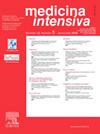Lack of correlation between central venous minus arterial PCO2 to arterial minus central venous O2 content ratio and respiratory quotient in patients with septic shock: A prospective observational study
IF 2.7
4区 医学
Q2 CRITICAL CARE MEDICINE
引用次数: 0
Abstract
Objective
Central venous-arterial PCO2 to arterial-central venous O2 content ratio (Pcv-aCO2/Ca-cvO2) is commonly used as a surrogate for respiratory quotient (RQ) and tissue oxygenation. Although Pcv-aCO2/Ca-cvO2 might be associated with hyperlactatemia and outcome, neither the interchangeability with RQ nor the correlation with conclusive variables of anaerobic metabolism has never been demonstrated in septic shock. Our goal was to compare Pcv-aCO2/Ca-cvO2 and RQ in patients with septic shock.
Design
Prospective, observational study.
Setting
Two adult ICUs.
Patients
Forty-seven patients with septic shock on mechanical ventilation with stable respiratory settings and vasopressor dose after initial resuscitation.
Interventions
None.
Main variables of interest
We measured arterial and central venous gases, Hb, and O2Hb. Pcv-aCO2/Ca-cvO2 and the ratio of central venous-arterial CO2 content to arterial-central venous O2 content (Ccv-aCO2/Ca-cvO2) were calculated. RQ was determined by indirect calorimetry.
Results
Pcv-aCO2/Ca-cvO2 and Ccv-aCO2/Ca-cvO2 were not correlated with RQ (R2 = 0.01, P = 0.50 and R2 = 0.01, P = 0.58, respectively), showing large bias and wide 95 % limits of agreement with RQ (1.09, -1.10−3.27 and 0.42, -1.53−2.37). A multiple linear regression model showed Hb, and central venous PCO2 and O2Hb, but not RQ, as Pcv-aCO2/Ca-cvO2 determinants (R2 = 0.36, P = 0.0007).
Conclusions
In patients with septic shock, Pcv-aCO2/Ca-cvO2 did not correlate with RQ and was mainly determined by factors that modify the dissociation of CO2 from Hb. Pcv-aCO2/Ca-cvO2 seems to be a poor surrogate for RQ; therefore, its values should be interpreted with caution.
感染性休克患者中心静脉负动脉PCO2与动脉负中心静脉O2含量比与呼吸商缺乏相关性:一项前瞻性观察研究
目的中心静脉-动脉PCO2与动脉-中心静脉O2含量比(Pcv-aCO2/Ca-cvO2)常被用作呼吸商(RQ)和组织氧合的替代指标。尽管Pcv-aCO2/Ca-cvO2可能与高乳酸血症和预后有关,但在感染性休克中,其与RQ的互换性以及与无氧代谢的结论性变量的相关性尚未得到证实。我们的目的是比较感染性休克患者的Pcv-aCO2/Ca-cvO2和RQ。前瞻性观察性研究。设置2个成人icu。患者47例败血症性休克患者首次复苏后采用机械通气,呼吸条件稳定,血管加压剂剂量稳定。干预措施1 .主要感兴趣的变量我们测量了动脉和中心静脉气体、Hb和O2Hb。计算Pcv-aCO2/Ca-cvO2、中心静脉-动脉CO2含量与动脉-中心静脉O2含量之比(Ccv-aCO2/Ca-cvO2)。RQ采用间接量热法测定。结果spcv - aco2 /Ca-cvO2和Ccv-aCO2/Ca-cvO2与RQ不相关(R2 = 0.01, P = 0.50和R2 = 0.01, P = 0.58),偏差较大,与RQ的一致性限为95%(1.09,-1.10−3.27和0.42,-1.53−2.37)。多元线性回归模型显示Hb、中心静脉PCO2和O2Hb是Pcv-aCO2/Ca-cvO2的决定因素,但RQ不是(R2 = 0.36, P = 0.0007)。结论在脓毒性休克患者中,Pcv-aCO2/Ca-cvO2与RQ无关,主要由改变Hb中CO2解离的因素决定。Pcv-aCO2/Ca-cvO2似乎不能很好地代替RQ;因此,应该谨慎地解释它的值。
本文章由计算机程序翻译,如有差异,请以英文原文为准。
求助全文
约1分钟内获得全文
求助全文
来源期刊

Medicina Intensiva
CRITICAL CARE MEDICINE-
CiteScore
2.70
自引率
20.00%
发文量
146
审稿时长
33 days
期刊介绍:
Medicina Intensiva is the journal of the Spanish Society of Intensive Care Medicine and Coronary Units (SEMICYUC) and of Pan American and Iberian Federation of Societies of Intensive and Critical Care Medicine. Medicina Intensiva has become the reference publication in Spanish in its field. The journal mainly publishes Original Articles, Reviews, Clinical Notes, Consensus Documents, Images, and other information relevant to the specialty. All works go through a rigorous selection process. The journal accepts submissions of articles in English and in Spanish languages. The journal follows the publication requirements of the International Committee of Medical Journal Editors (ICMJE) and the Committee on Publication Ethics (COPE).
 求助内容:
求助内容: 应助结果提醒方式:
应助结果提醒方式:


